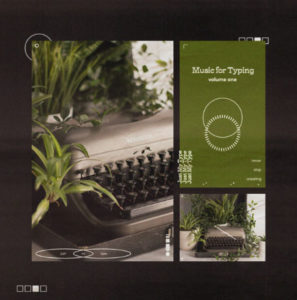I work better with other people’s sounds around me–not all, just some–and now there’s research to support that yes, indeed, ambient sound, like that which you hear at a coffee house, inspires creativity. Here you can turn on ambient noise from a coffee house, and also read the study that talks about why ambient sound is good for creativity.
Yearly Archives: 2010
Lessons from Harry Potter
I will admit here and now, before the world, that I’m not a Harry Potter fan. I don’t dislike the books; I just don’t love that genre of fiction. But I admire writers like J.K. Rowling, especially writers who are at the end of their ropes and then have a vision and get that vision onto the page and become a raging success. I wish I’d have a vision like that.
So, here is a speech Cheryl Klein, continuity editor of the U.S. Harry Potter books, gave. See what you think.
When’s the last time you did something writerly?
I’m not talking about sitting down to write, or going to your writing class or workshop, or reading a good book. I’m talking about going away, just you, to be with other writers and take part in workshops. It might be a writers’ colony or a weekend workshop or a writers conference. I just returned from the ASJA writers conference in New York City. It’s a conference we put on every year and every year it’s a good one. (The weekend prior was the Los Angeles Times Festival of Books, which I always enjoy.) At the ASJA conference, I met with agents and I spent time with writers I only see when I’m in New York. I haven’t laughed so much or hard since I can’t remember when. I returned charged up and motivated. Summer is almost here and along with it are so many writers conferences and events. If you want to do something nice for yourself and your writing life, attend at least one. Promise?
Like collecting sea glass, little by little, the words add up
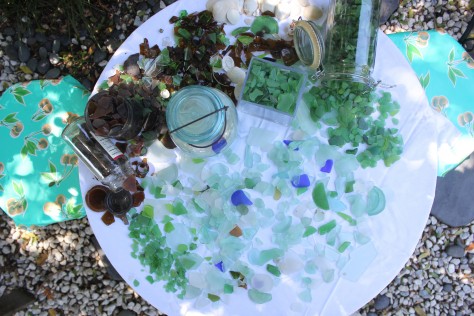
My son Travis and I gathered the sea glass collected over the years–mostly by me, a little bit by friends–since moving to a cottage a few long blocks from the beach, and in unison said, “Whoa!” There was a lot there. Brown glass, green glass, white and sea foam, and a few stray shades, anomalies. The most I bring home from a walk are a few pieces at a time, and not every day. Maybe an average of once a week. And sometimes weeks will go by, even months, without looking for it, or finding any.
I was thinking how the sea glass adding up is so like writing. It’s not uncommon for people who want to be writers, or who feel they have a book in them, to dream of having that year or month or even two week uninterrupted span when they have nothing else to do but write, and when that time comes, they will get the book written, or the short stories or essays.
What works better for me and for most successful–or productive writers, for who can truly say what success is?–is chipping away at projects. And I was reminded of collecting sea glass, and how the sea glass you see here was collected over the years–about 20. You’d never find this much in a couple of weeks, or months, no matter how you tried. This is why you can go on eBay and buy bags of “sea glass style” pieces (not truly sea glass but glass tossed in a rock tumbler to resemble sea glass): because it’s ain’t easy to find it. The conditions have to be right; the tide has to be low.
I look at our containers of sea glass and I remember. This is how words pile up: over time, little by little, bit by bit.
Photo credit: Travis Barrett
Can you tell a book by its cover?
Here‘s a fun literary game for you to put off writing for a minute.
George Saunders on Writers on Writing
My guest host Marrie Stone talks with New York Times bestselling author Tenth of December: Stories about his latest short story collection Tenth of December.
(Broadcast date: March 13, 2013)
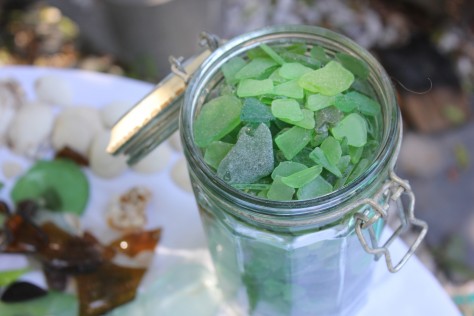

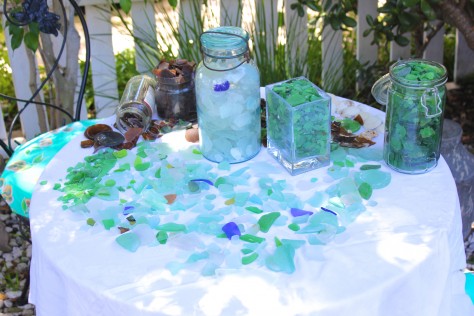

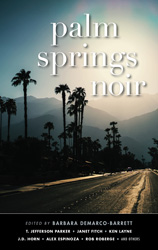


 Support Indie bookshops and this site by purchasing books through my BookShop
Support Indie bookshops and this site by purchasing books through my BookShop
